Jue, Feb 23rd 2023
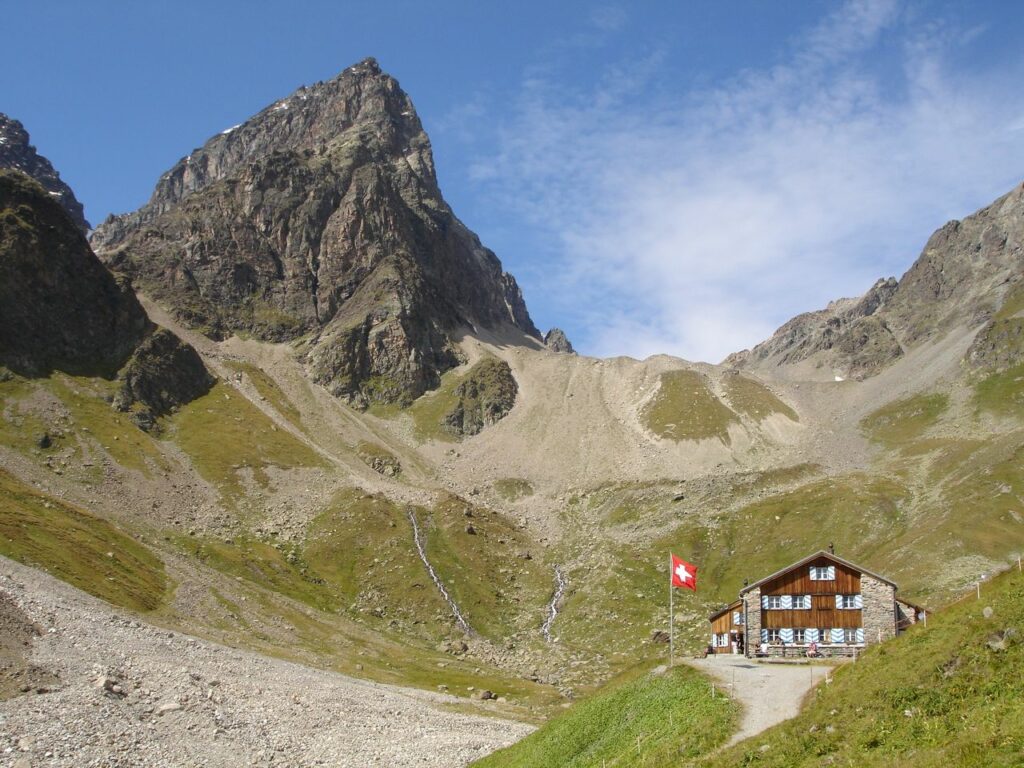
Chamonna Tuoi Hut near the border of Lichtenstein is one of the more famous of Switzerland’s mountain huts (Credit: Schweizer Alpen-Club).
In this article, you’ll find the history of mountain huts, what to expect when staying at a hut, and pro tips from Christine Meier Zürcher, a seasoned mountaineer and President of the Einsiedeln branch of the Swiss Alpine Club.
Shelters in the alps have existed since Roman times when roads connecting the empire wound their way through the mountain passes. And as far back as the 14th century, Swiss herders known as Älpler have spent their summers in alpine shelters while their animals grazed on the sweet grass in high mountain valleys.
The dedicated hut system that we know today first began in 1863 with the start of the famed Swiss Alpine Club. During the 1850s, alpine hiking became increasingly popular. With the increased interest came the Alpine Club in London in 1854 and the Österreichischer Alpenverein in Austria in 1862. Then in 1863, as more mountaineers began to explore the Swiss Alps, Rudolf Theodor Simler, a chemistry and geology professor at Bern University, started the Swiss Alpine Club.
That same year, the Tödi and Clariden regions in Glarus were designated as areas of exploration, and the Grünhorn Hut was built on the eastern side of Tödis at 2448 meters above sea level. Within the first 25 years of existence, the Swiss Alpine Club built 37 additional mountain huts, including the famous Hörnli Matterhorn hut built in 1865.
Along with creating a network of mountain paths and helping map alpine regions, the SAC is the largest Alpine club in Switzerland, with over 160,000 members, 111 chapters, and 153 huts. In 2018 alone, there were 345,000 overnight stays in a Swiss Alpine Club Hütten.
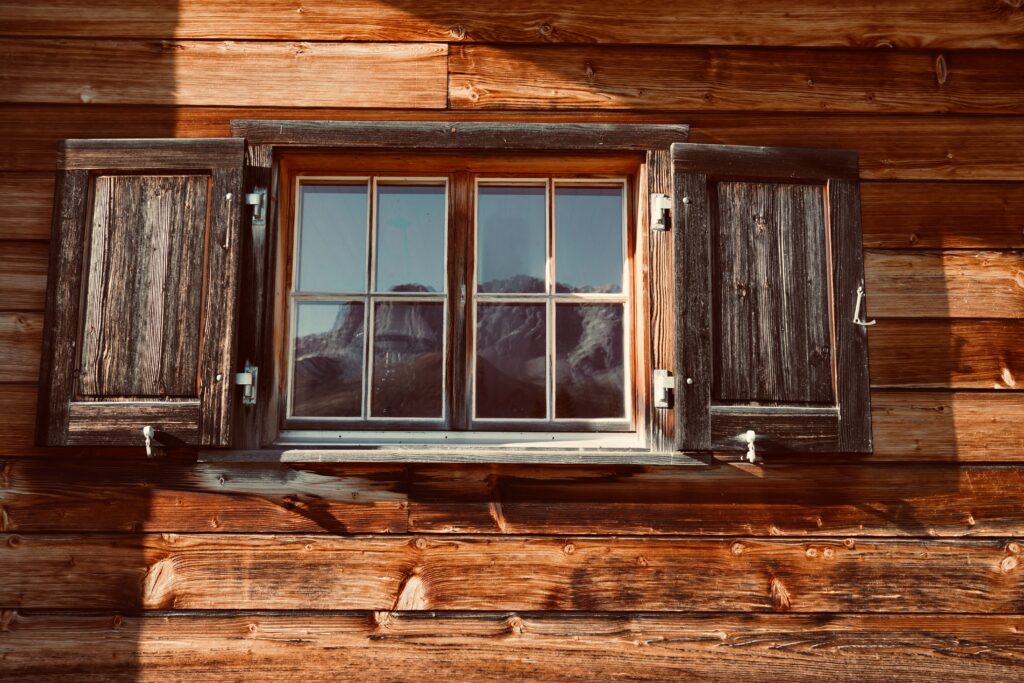
Swiss mountain huts are not hotels. They are often dormitory-style, so pack your earplugs.
The Swiss Alpine Club has the most extensive network of huts, with 153 in total. Christine Meier Zürcher, President of the Einsiedeln chapter of the Swiss Alpine Club, explains that SAC huts are owned and cared for by the individual branches of the SAC. The central association will step in to help if a hut needs updates or renovations. The SAC Hüttenwarte, or hut wardens, who care for the hut and guests, are also hired by the individual branches.
Outside of the SAC network, there are hundreds of huts privately owned and operated by individuals, families, or cooperatives. For example, the My Switzerland booking site, alp.holidaybooking.ch, has over 250 huts to choose from.
Back in the 19th century, before cable cars and helicopters, mountain hut facilities were primitive shelters built by alpinists made of wood and stone. Over the years, mountain huts have substantially improved with the use of modern building materials. While modern mountain huts are a huge improvement from those built in the 19th century, hut accommodation is still paired down. Swiss Mountain huts provide rustic facilities, but that is all part of the experience. Most huts have shared dorm-style rooms that host about 20 people, and some have smaller rooms with a few beds. For example, the largest SAC hut has space for 155 hikers, while the smallest has just eight beds.
Some huts are self-service, meaning unstaffed. These huts are usually in high alpine regions, where only a few of the most serious climbers stay each season. But most huts have a hut warden who cares for the hut and guests and makes meals. Huts have basic, shared washing and toilet facilities. Many huts have running water that’s usually freezing cold, but you should bring a towel and soap as these aren’t provided. If a shower is available, it may be at an extra cost and might be very chilly. Every bed will come with a pillow, sheet, and warm blanket, but bring your own pillow case and sleeping bag liner to make your stay more comfortable and pleasant for the next hiker.
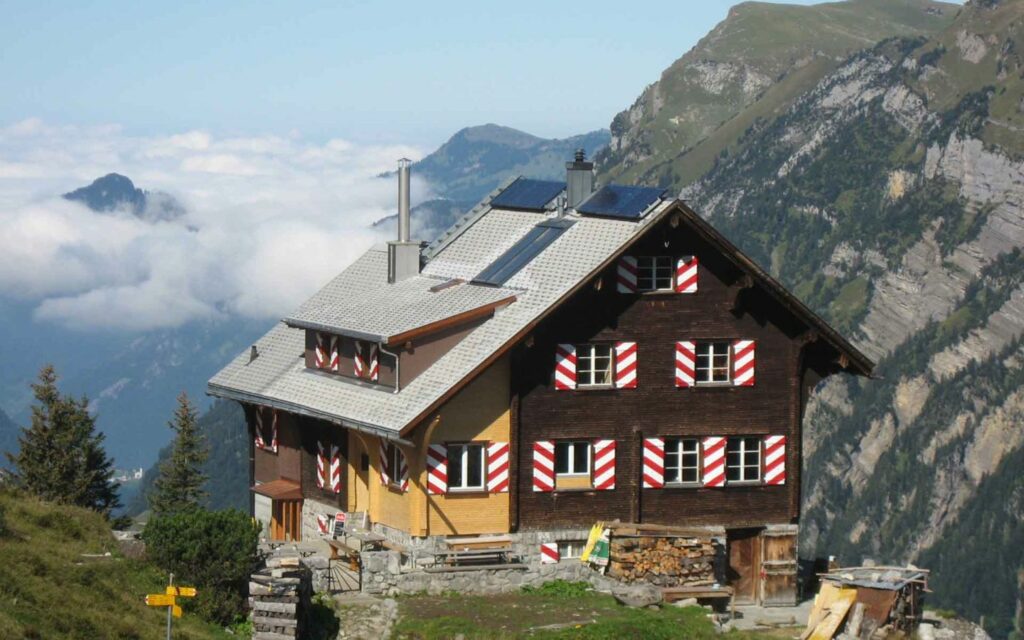
The Lidernen Hut is only one hour outside of Zurich, making it easy for international travelers to access (Credit: Schweizer Alpen-Club).
All serviced SAC huts include half board, meaning dinner and breakfast are included. Hearty meals, perfect for refueling after a grueling day, are served family-style with other hikers and usually include a soup, main course, dessert, and sometimes a salad. Dinner is usually eaten around 18:30, so be sure to arrive at your hut by 18:00 or call ahead if you have service and are going to be late.
“Food in mountain huts is often really delicious and filling. Hut wardens know hikers need to be refueled at the end of a long day,” offers Meier Zürcher. “And particularly well-made Hütten-Tee, also called Marsch-Tee, is especially appreciated by seasoned hikers.”
For breakfast, you can expect a simple meal, often consisting of bread, butter, and cheese, with a hot beverage like coffee. If you have a long trek ahead of you, consider purchasing a handmade lunch from the hut staff.
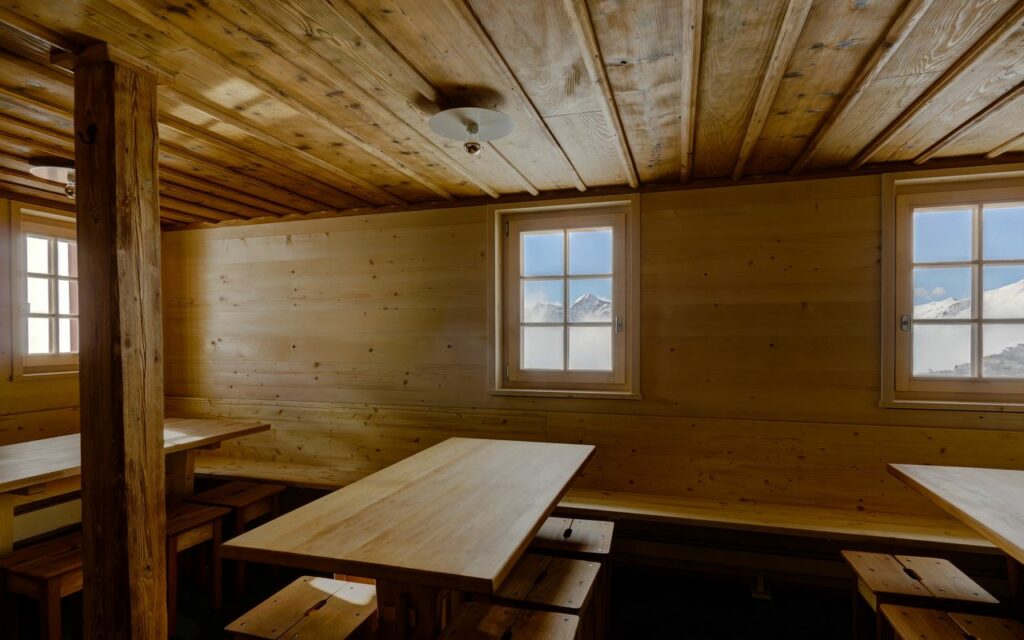
Lunch with a view (Credit: Schweizer Alpen-Club).
To keep the mountains accessible to as many people as possible, the cost of accommodation at Swiss mountain huts is intentionally affordable. Depending on the hut’s standards, size, facilities, and season an overnight stay in a SAC hut will cost, on average, between 25 CHF to 45 CHF per adult. Half-board usually ranges between 60 CHF and 90 CHF and includes a bed, breakfast, and dinner at the hut.
“If you’re a SAC member, you’ll receive up to 20% off your stay, which is reciprocal with other alpine clubs. For example, members of the Italian Alpine Club will receive a discount at SAC huts in Switzerland. “So it’s worthwhile to become a member of the SAC if you’re going to be spending a few nights in the alps,” offers Meier Zürcher.
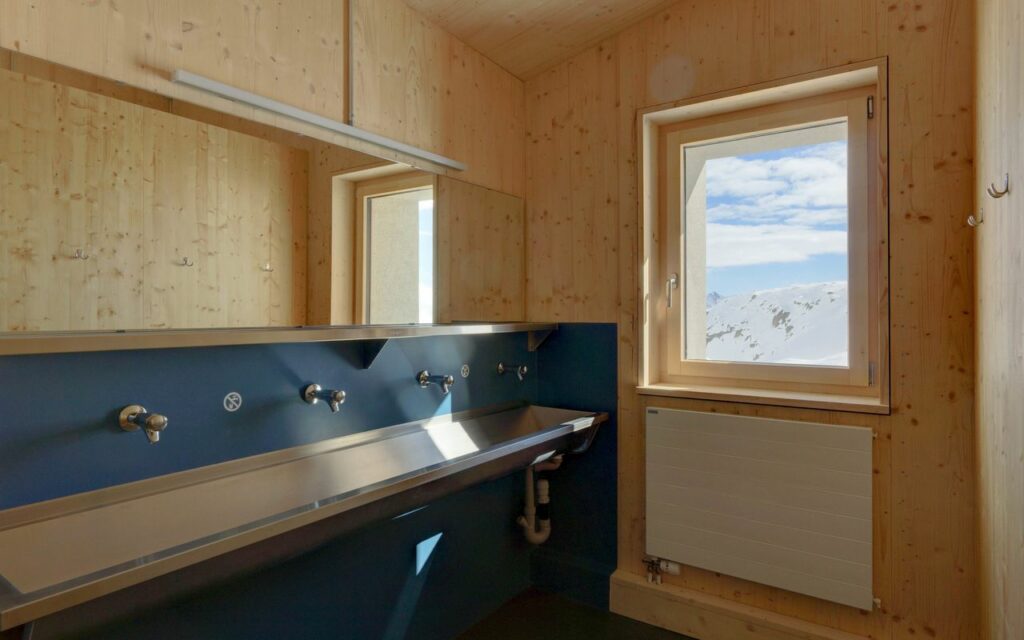
The showers will often be cold in Swiss mountain huts, but worth it for the views.
There are more luxurious facilities in some of the less remote huts, such as warm showers and private rooms, but these spaces come at a premium. You can also find huts with more of a holiday apartment feel and creature comforts available, like the Maiensäss Tschividains in Lenzerheide, which will be reflected in the price tag.
“Within the community, there’s discussion around how mountain hut culture is changing as hikers today have higher expectations. More and more mountain huts are adding amenities like showers and privacy walls between beds. Still, these changes could take away from the authentic experience of staying in a hut,” Meier Zürcher says.

Some huts do have private rooms or family rooms, but most sleep guest dormitory style (Credit: Schweizer Alpen-Club)
Most huts are open from mid-June to September or October. Later in the season, huts may close on short notice due to weather, but the SAC has around 70 huts that are partially available in Spring and Winter. During the peak summer season, June through September, reservations are required.
Once you’ve planned your hiking route, you can easily book a hut with a quick Google search or go directly to the SAC booking portal. The portal will also bring you to the hut’s individual website, where you’ll find more information, including suggested routes to and from the hut. If you’re hiking in a group or with children, try the family-friendly hut filter. Cashless payments are often available through the mountain hut’s website, but remember to bring cash with you to pay for any extras you purchase.
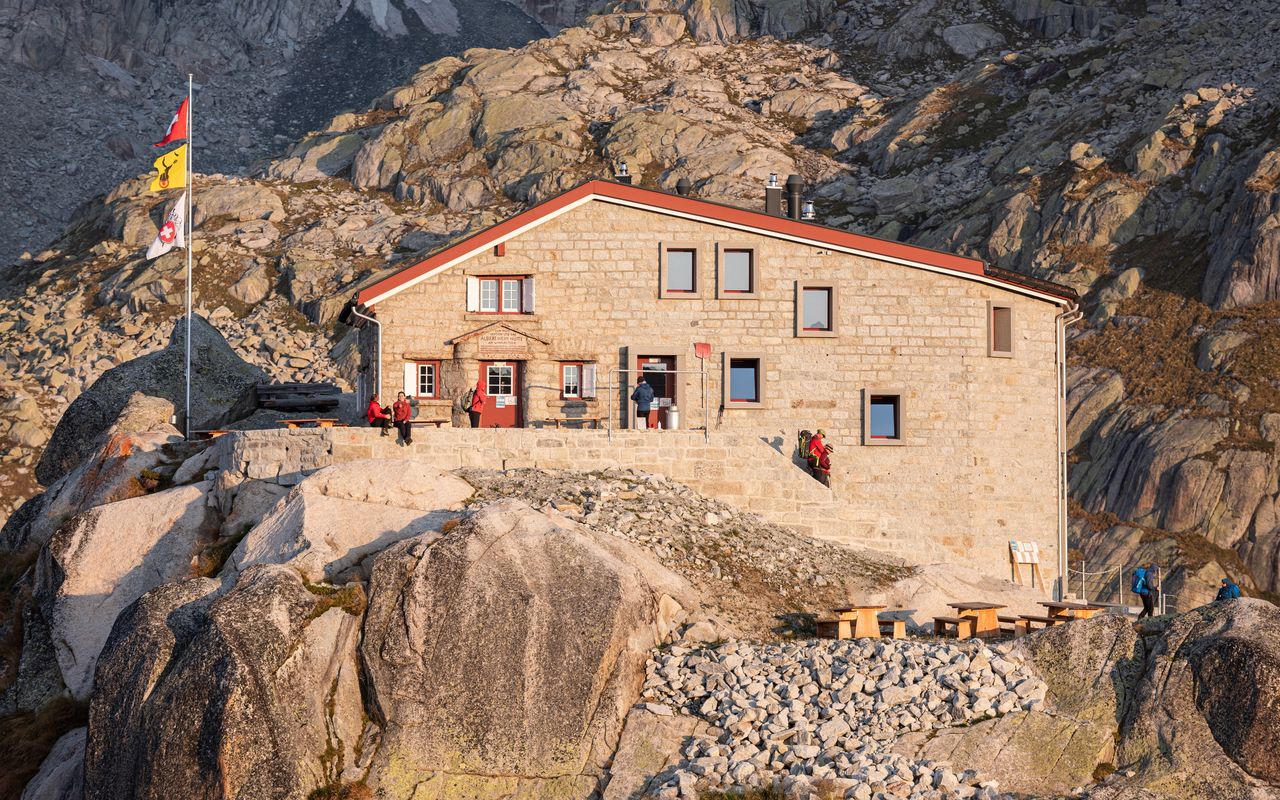
The Albert Heim Hut is one of the newer huts with some of the most breathtaking views of Switzerland (Credit: Schweizer Alpen-Club)
There are clear spoken and unspoken rules when staying in a mountain hut. Here are helpful tips from Meier Zürcher:
Hiking in Switzerland is a family activity, and there are plenty of family-friendly huts available with hikes from beginner level to advanced. Mountain paths in Switzerland are well-maintained, marked, and made to be accessible. Many huts offer family rooms or spaces with more privacy than bunk rooms. If you’re hiking with your dog, be sure to call ahead or check the hut website for rules about bringing a dog.
If you don’t have the opportunity to spend a night in the alps, you can still enjoy the Swiss mountain hut culture. There are plenty of huts available to day hikers where you can stop and grab a beer and a chäseteller, use the toilet and rest your legs.
If you want a challenging but doable day hike with a stunning 360-degree panorama and a beautiful mountain hut, try the Grosser Mythen.
Este artículo puede compartirse y reimprimirse libremente, siempre que se incluya un enlace al artículo original.
